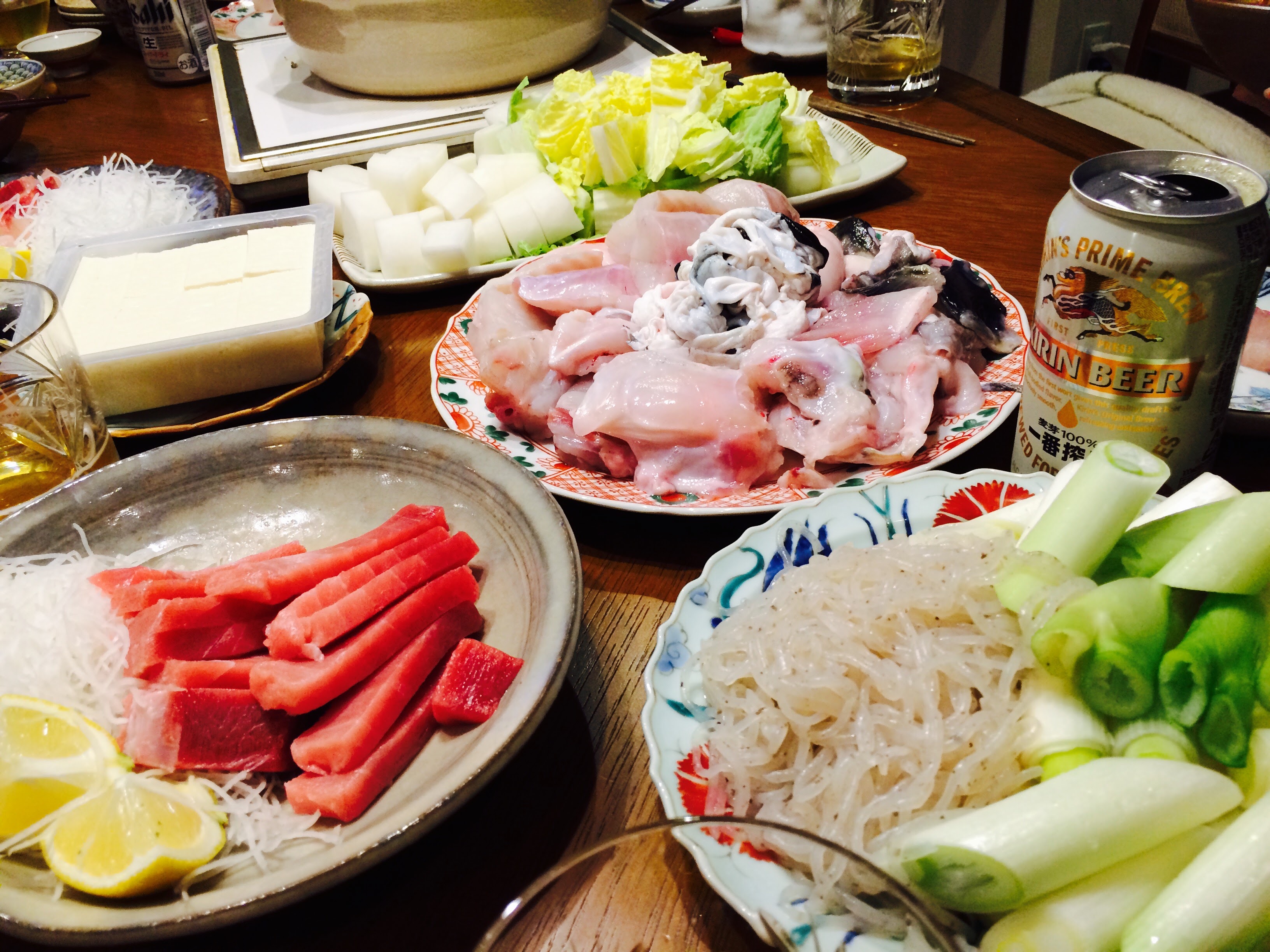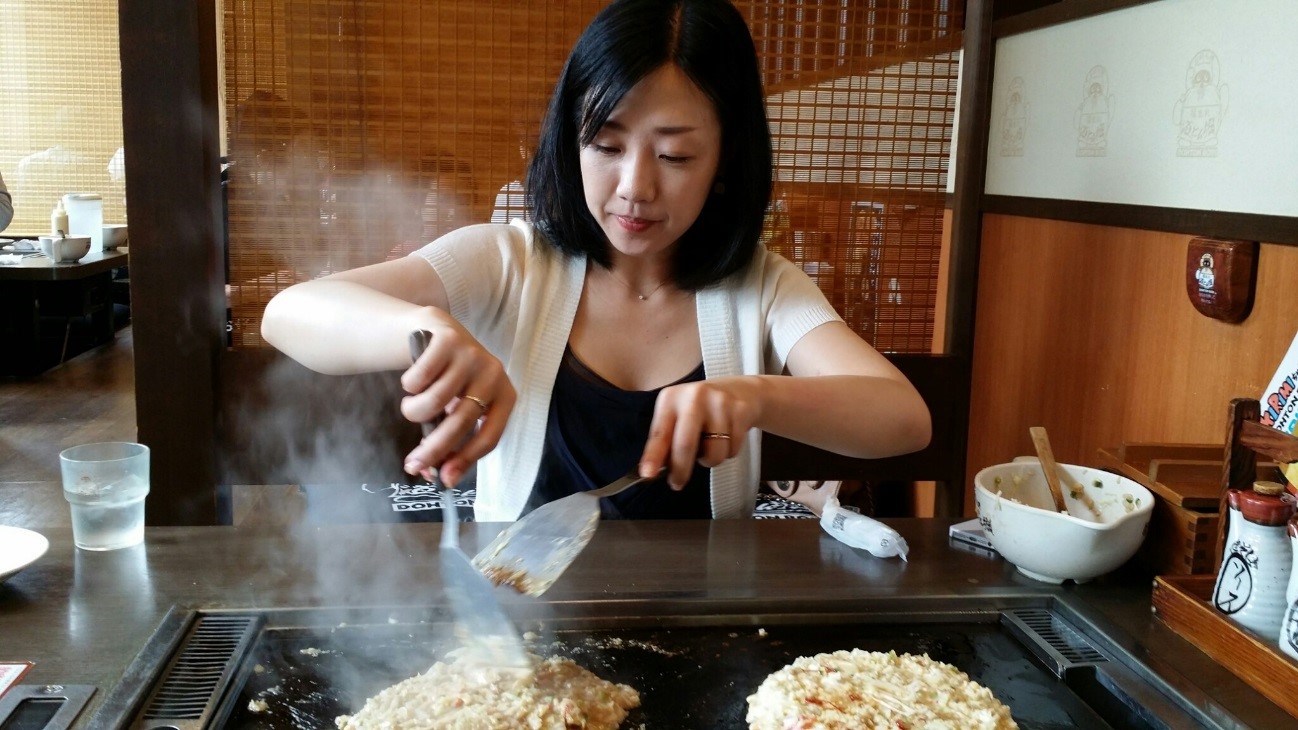Poison and Food Taboos
Our summer series, Perspectives from Anthropology of Food, continues with this post from Gastronomy student Madoka Sasa.

The center of the dish is skin of blowfish. (photo credit: Madoka Sasa)
In the article “Anthropology of Food,” R. Kenji Tierney and Emiko Ohnuki-Tierney (2012, 118) describe blowfish consumption in Japan:
Not all objectively “edible” items are regarded as food for a people, even in times of severe food shortages. For example, frogs are abhorred by the Ainu, while the French consider them a great delicacy. Some Japanese men relish blowfish, whose poison can kill instantly, not necessarily for its taste but in order to demonstrate masculinity.
I was impressed. This is the first time I had read that Japanese men eat blowfish to show their masculinity.
According to a brochure issued by the Japan Fisheries Resources Conservation Association (2002), Japanese people have been eating blowfish since the Jomon period (14000 B.C. – 4 B.C.). Nowadays, due to advances in processing technology, if you eat blowfish that is properly prepared, you will rarely get poisoned. However, blowfish poisoning has caused a lot of deaths throughout history, because there are different poisonous parts depending on types, and there are some types of blowfish that are difficult to distinguish from each other.
In researching food rules, preferences, taboos, and avoidance, many scholars have pointed out that accepting an invitation to a feast may not only be an act of solidarity but the invitation itself may also be a test of loyalty for the community (Bloch 1999; Carlson 1990; Nell 2015). Considering the question of why Japanese people continue to eat such dangerous fish, it seems reasonable to suggest that it is a show of masculinity rather than consumption for taste. As we know that there is a possibility of poisoning, this is a pretty serious test showing masculinity and loyalty. But this story leads me to ask another question. For whom did they eat blowfish? In other words, for whom did they take such a risk?
Indeed, it seems that the blowfish eating habit in Japan has sparked many such discussions over its long history. For example, in the brochure of the Japan Fisheries Resources Conservation Association (2002), it is said that Toyotomi Hideyoshi issued a ban on eating blowfish, as many samurai who gathered in Shimonoseki (a famous city for blowfish) were poisoned. In the Edo period (1573–1603), many feudal domains decided to ban eating blowfish. According to the Association for Japanese History and Travel (2014), it is said that when the head of a family died of blowfish poisoning, the family had its lineage abolished by the daimyō feudal lord, because “the head had lost his life due to his gluttonousness, though he was supposed to serve the daimyō at the risk of his life.”
On the other hand, Matsuo Bashō, a famous haiku poet in the Edo era, wrote a poem about blowfish (Japan Fisheries Resources Conservation Association 2002, 15):
Awanu koi Omoi kiru yoru Fukuto-jiru. (逢わぬ恋 思い切る夜 ふくと汁)
This is a poem about a broken heart. The speaker says, “I decided to give up because I cannot meet you. As I am so desperate, I will eat blowfish soup tonight.” It can be said that it is a poem that expresses a very disappointed feeling. But at the same time, it is somewhat humorous, implying that a broken heart is an excuse for eating blowfish soup, which is delicious but forbidden.
In addition to this, Bashō says, “You also have a relish of red snapper, but you go out of your way to eat blowfish. I will only just say that you are unwise” (Japan Fisheries Resources Conservation Association 2002, 15). It seems that we have no choice but to be amazed by the insatiable desire for eating blowfish among Japanese males, despite the serious danger of dying and becoming unable to fulfill our obligations.
From these descriptions, the following conclusion can be drawn. While there is a ruling class that prohibits people from eating blowfish to prevent them from dying, people in general cannot control their desire to eat. According to the Japan Fisheries Resources Conservation Association (2002), eating blowfish was pretty popular among ordinary people in the Edo era. In other word, regarding the question “for whom are they eating blowfish?” it seems that the answer is “for myself.”
To “eat to be happy” is too obvious. But I imagine that eating blowfish and showing masculinity is also a way to feel happiness, or even to pursue a better life. I can sympathize with the feeling that “I cannot resist eating my favorite food, even if it is not good for my health,” whether 400 years ago or today. In the same way, the act of showing masculinity by eating puffer fish is an act that I can understand as reasonable if I know when, who, and under what circumstances it occurred. And this resonates with one of the themes of anthropology, understanding other cultural perspectives. For example, the people of Malagasy, observed by Maurice Bloch (1999), ingest an “antidote” when they have to eat with people from different villages or distant relatives. This helps eliminate discomfort and stress caused by unintentional shortening of the distance with a person who is not close. Although their culture is quite different from mine, the situations where people feel stressed are similar. In other words, even though the act of other cultures seems to be unusual, I think the feeling underlying the act is often understandable for us: making good relationships with others, satisfying self-respect, or relieving stress. So it is very interesting for me to find the similarity of mind beyond time and culture, and to see each culture’s interpretation of the world that is used to make life more comfortable.

It is well known that various cultures around the world have “food” that is “good to eat” which is unacceptable for people in other cultures, for example, clay, dogs, insects, dolphins and so on. However, the reason for eating them could be something which many people can feel sympathy toward. It makes me more interested in thinking about food rules, preferences, taboos, and avoidance.
Bibliography
Association for Japanese History and Travel. 2014. “Shimonoseki ni Fuku wo Maneita Fugu.” Accessed June 29, 2017. http://japan-history-travel.com/?p=3950.
Bloch, Maurice. 1999. “Commensality and Poisoning.” Social Research 66 (1):133–49.
Carlson, Robert G. 1990. “Banana Beer, Reciprocity, and Ancestor Propitiation Among the Haya of Bukoba, Tanzania.” Ethnology 29(4): 297–311.
Krögel, Alison. 2009. “Dangerous Repasts: Food and the Supernatural in the Quechua Oral Tradition.” Food and Foodways 17 (2):104–32.
Nell, Cornelia A. 2015. “Commensality and Sharing in an Andean Community in Bolivia.” In Commensality: From Everyday Food to Feast, edited by Susanne Kerner, Cynthia Chou, and Morten Warmind, 165–76. New York: Bloomsbury.
Nihon Suisan Shigen Hogo Kyokai. 2002. Waga Kuni no Suisangyo Shirizu: Fugu. Accessed June 29, 2017. http://www.fish-jfrca.jp/02/pdf/pamphlet/074.pdf.
Tierney, R. Kenji, and Emiko Ohnuki-Tierney. 2012. “Anthropology of Food.” In Oxford Handbook of Food History, edited by Jeffrey M. Pilcher, 117–34. New York: Oxford University Press.